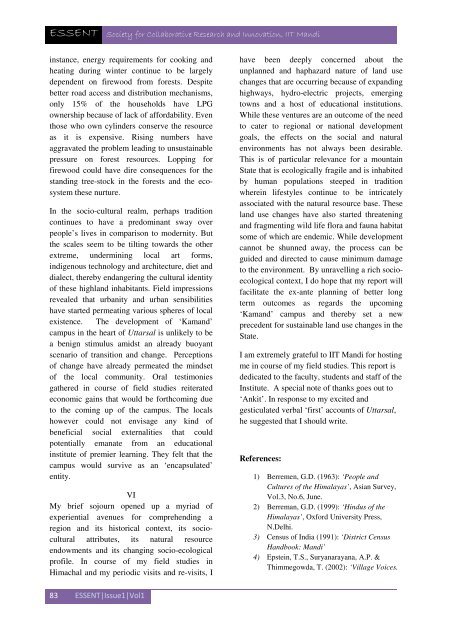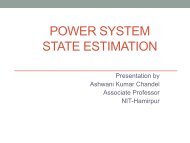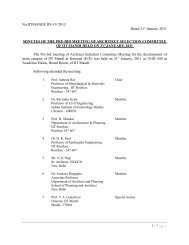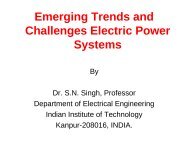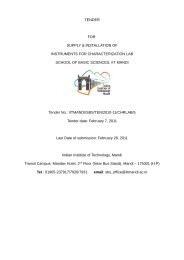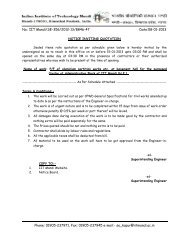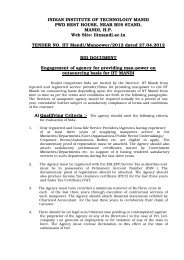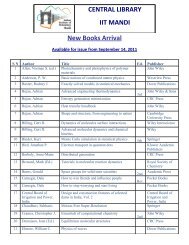Issue1. Vol.1 (April, 2013) - IIT Mandi
Issue1. Vol.1 (April, 2013) - IIT Mandi
Issue1. Vol.1 (April, 2013) - IIT Mandi
- No tags were found...
You also want an ePaper? Increase the reach of your titles
YUMPU automatically turns print PDFs into web optimized ePapers that Google loves.
ESSENT Society for Collaborative Research and Innovation, <strong>IIT</strong> <strong>Mandi</strong>instance, energy requirements for cooking andheating during winter continue to be largelydependent on firewood from forests. Despitebetter road access and distribution mechanisms,only 15% of the households have LPGownership because of lack of affordability. Eventhose who own cylinders conserve the resourceas it is expensive. Rising numbers haveaggravated the problem leading to unsustainablepressure on forest resources. Lopping forfirewood could have dire consequences for thestanding tree-stock in the forests and the ecosystemthese nurture.In the socio-cultural realm, perhaps traditioncontinues to have a predominant sway overpeople’s lives in comparison to modernity. Butthe scales seem to be tilting towards the otherextreme, undermining local art forms,indigenous technology and architecture, diet anddialect, thereby endangering the cultural identityof these highland inhabitants. Field impressionsrevealed that urbanity and urban sensibilitieshave started permeating various spheres of localexistence. The development of ‘Kamand’campus in the heart of Uttarsal is unlikely to bea benign stimulus amidst an already buoyantscenario of transition and change. Perceptionsof change have already permeated the mindsetof the local community. Oral testimoniesgathered in course of field studies reiteratedeconomic gains that would be forthcoming dueto the coming up of the campus. The localshowever could not envisage any kind ofbeneficial social externalities that couldpotentially emanate from an educationalinstitute of premier learning. They felt that thecampus would survive as an ‘encapsulated’entity.VIMy brief sojourn opened up a myriad ofexperiential avenues for comprehending aregion and its historical context, its socioculturalattributes, its natural resourceendowments and its changing socio-ecologicalprofile. In course of my field studies inHimachal and my periodic visits and re-visits, Ihave been deeply concerned about theunplanned and haphazard nature of land usechanges that are occurring because of expandinghighways, hydro-electric projects, emergingtowns and a host of educational institutions.While these ventures are an outcome of the needto cater to regional or national developmentgoals, the effects on the social and naturalenvironments has not always been desirable.This is of particular relevance for a mountainState that is ecologically fragile and is inhabitedby human populations steeped in traditionwherein lifestyles continue to be intricatelyassociated with the natural resource base. Theseland use changes have also started threateningand fragmenting wild life flora and fauna habitatsome of which are endemic. While developmentcannot be shunned away, the process can beguided and directed to cause minimum damageto the environment. By unravelling a rich socioecologicalcontext, I do hope that my report willfacilitate the ex-ante planning of better longterm outcomes as regards the upcoming‘Kamand’ campus and thereby set a newprecedent for sustainable land use changes in theState.I am extremely grateful to <strong>IIT</strong> <strong>Mandi</strong> for hostingme in course of my field studies. This report isdedicated to the faculty, students and staff of theInstitute. A special note of thanks goes out to‘Ankit’. In response to my excited andgesticulated verbal ‘first’ accounts of Uttarsal,he suggested that I should write.References:1) Berremen, G.D. (1963): ‘People andCultures of the Himalayas’, Asian Survey,Vol.3, No.6, June.2) Berreman, G.D. (1999): ‘Hindus of theHimalayas’, Oxford University Press,N.Delhi.3) Census of India (1991): ‘District CensusHandbook: <strong>Mandi</strong>’4) Epstein, T.S., Suryanarayana, A.P. &Thimmegowda, T. (2002): ‘Village Voices.83 ESSENT|Issue1|Vol1


